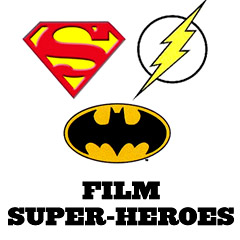 Major
Comic-Book (or Comic-Strip) Super-Heroes Major
Comic-Book (or Comic-Strip) Super-Heroes
Fictional super-heroes with extraordinary
powers, derived from comic books, newspaper comic-strips,
pulp magazines and other sources, have since become the
subjects of numerous fantasy and sci-fi films (both live-action
and animated, serialized and feature-length, on TV and on the
big screen) with action-oriented heroes and heroines, almost
too many to mention fully. They have inspired generations of
readers, TV audiences, and movie-goers, and have dealt with
a variety of deep personal, political and social issues.

Main Super-Hero Characteristics
|
Name and/or Secret Identity:
a special name, that possibly described their superhero
type; also a secret or special
identity or alter-ego (many superheroes have dual identities
or names - civilian and super), often thematic (Batman's
bat motifs)
|
Special Powers, Traits or
Extraordinary Skills:
possession of superhuman traits or powers (mental
or physical skills, including, for example, super-strength,
super-eyesight, super-invulnerability, etc.); includes
possible weaknesses
|
Main Enemy or Supervillain:
Most superheroes have a main enemy or arch-enemy (Superman
often battled Lex Luthor, or Batman pursued the Joker)
with some sort of backstory for their evil nature
|
Unique Costume or Look:
an iconic costume (often with a mask or cape); costumes
had symbolic colors or were unique in appearance; superheroes
often changed into costumes to
assume super-hero duties
|
Accessory, Gadget, Weapon, and/or Vehicle:
a symbolic gadget (weapon, or accessory) with special
powers (Wonder Woman's tiara, Thor's hammer ), or an
accessory (such as the Batmobile)
|
Mission or Objective:
an objective or altruistic mission to accomplish (save
the world and humanity, from villains, aliens, Nazis,
the Axis Powers, etc.), sometimes motivated by an inciting
event (alien landing, or scientific accident, or instilled
moral code, etc.)
|
Associated Sidekick or Team:
accompanied by a sidekick (Batman's Robin) or part of
a team of other superheroes (the X-Men, the Fantastic
Four)
|
Origin Story or Backstory:
A long history or backstory, explaining a past or previous
identity, and other background, usually fanciful or mythical;
could include the reason for becoming a superhero (murder
of Peter Parker's uncle)
|
Home, Location, Base, or Headquarters:
Place of residence or main activity, (Gotham City, Atlantis,
etc.) and/or secret hiding place (the Batcave)
|
Sidekicks were added to superhero plots to make
them more appealing to kids - including comics' first sidekick,
Robin/Dick Grayson for Batman (others included Bulletgirl for
Bulletman, Sandy for the Sandman, Speedy for the Green Arrow,
Kitten for Cat-man, Toro for the Human Torch, and Tim for the
Black Terror). The desired hope was to increase the number
of younger readers who could better identify with the heroes.
Superheroes have been repeatedly chosen as the
subjects of big-budget blockbuster films, but not at first.
Although superheroes had already taken over TV, it took until
1978 for the first big-budget feature film to feature a superhero
- Superman: The Movie (1978).
Especially since the dawning of the new Millennium,
superheroes have multiplied on the big-screen, with glossy
production values, expensive CGI special effects and sets,
make-up and costuming. Usually, their simplistic plot lines
involve the superhero's (or superteam's) struggle against an
arch-nemesis or super-villain (usually interested in world
domination, the acquisition of riches, or the wreaking of vengeance).
The many superhero films usually end with climactic showdowns.
The difficulty with compiling a list of films (or TV series)
related to comic-book heroes is that there are so many varieties:
live-action, animated, TV series, feature-length, and other
original or adapted combinations.
History: Some of the First 'Superheroes'
Even before the appearance of Superman and other
traditional super-heroes in comic books, other early media
sources (including newspaper comic strips, radio, and pulp
fiction publications) were beginning to feature sci-fi heroes,
adventurers, magicians, vigilantes, and other crime-fighting
'superhero' type characters, such as:
| Buck Rogers |

|
The first US newspaper comic-strip
space pioneer (January 1929), and later first appearing
on the radio in serial form (November 1932, lasting until
1940, and then revived from 1946-1947). The first comic
book appearance of Buck Rogers was in Famous Funnies
# 3 (October 1934) |
| The Shadow |

|
The first radio and pulp fiction adventure/vigilante
hero (debuted as a radio show narrator on July 31, 1930,
and in a pulp fiction magazine in April 1931) |
| Dick Tracy |
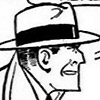
|
A newspaper comic strip detective (debuted
in October 1931) |
| Flash Gordon |
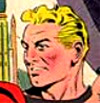
|
A science-fiction/adventure newspaper comic-strip
character (debuted in January 1934) |
| Mandrake the Magician |

|
A newspaper comic-strip character in the
first strip involving magic - Mandrake was a dapper, mustached
magician who used powers of illusion and hypnotism to fight
crime (debuted in June 1934) |
| The Phantom |

|
The first costumed, masked superhero (debuted
in February 1936) - in the first newspaper strip that introduced
the idea of a masked crime-fighter to a wide audience |
The Four Ages of Comic Books: Superheroes
There are four specific ages referred to when
speaking of superheroes, especially in regards to comic book
superheroes, who made their first appearances in the Golden
Age - in the late 1930s and early 1940s:
- The Golden Age (1936-1949) -
the late 1930s to the late 40s (some say early 1950s)
This was the era of the creation of the superhero archetype,
and the debut of many superhero characters, including Superman,
Batman, Captain America, Captain Marvel, and Wonder Woman.
After WWII, many superheroes began to decline or fade away,
except for the most popular (Superman, Batman and Robin, and
Wonder Woman). Comics in the early 1950s were no longer in
vogue, and were replaced by other more popular literary genres:
funny animal stories, teen comedies and romances, westerns,
gangsters, and horror stories. This was partially due to the
damaging efforts of psychiatrist Dr. Fredric Wertham, M.D.,
who argued in his 1954 book Seduction of the Innocent,
that comic books had a deleterious effect on children, including
giving kids erroneous ideas about physics (i.e., Superman could
fly!), and obscenely glorifying violence and crime.
- The Silver Age (1956-1969)
This was a period of revival of some older superheroes and
new entries (such as the Flash, Green Lantern, Spider-Man,
the Hulk, Thor, the X Men and Iron Man) and the creation
of superhero teams (including the Fantastic Four and the
Justice League), who were revamped, refashioned, or reintroduced,
with some success.
- The Bronze Age (1970-1985)
The maturing of comic-book heroes, with the
appearance of some socially-relevant and timely issues, and
some anti-superheroes (for example, The Punisher, Wolverine,
and Ghost Rider).
- The
Dark Age of Comic Books (mid-1980s-present)
(aka the Modern Age)
Superhero Comic Book Publishers: Rivalry
Marvel and DC Comics have been in a decades-long
battle for supremacy. Most
of DC's characters go back to the late 1930s
and 1940s, while most of Marvel’s main
characters are dated in the 1960s and 1970s.
There still existed a serious rivalry in the late 1930s and
early 1940s to achieve a foothold in the superhero comic-book
publishing field with a defining character. There was actually
a four issue, mini-series comic book released in 1996 that
celebrated the fact of the early rivalry between the two publishing
companies and their superheroes.
|
Marvel Comics vs. DC Comics
|
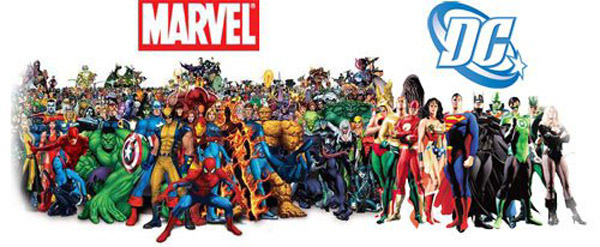
|
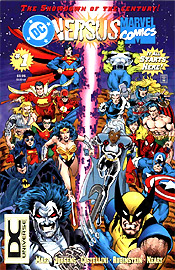
DC Versus Marvel Comics # 1
February 1996
|
|
Logo(s)
|
Comic Book Publishers |
|
DC Comics
|
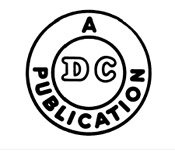
1940-1942
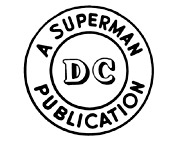
1942-1949
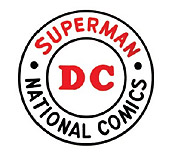
1949-1972
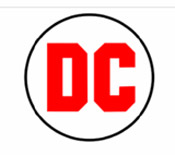
1972-1974
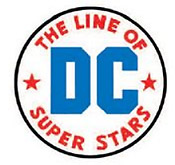
1974-1977
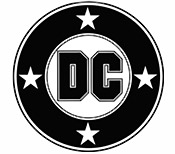
1977-2005
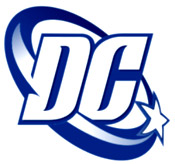
2005-2012
|
DC Entertainment was
originally known as "National Allied Publications" when
founded in 1934. National Allied Publications' first comic
was New Fun: The Big Comic Magazine # 1 (February
1935), followed by a second line of comics titled New
Comics # 1 (1935)
- both offered traditional comedy, "Adventure, Thrills
and Prizes." By issue # 12 (January 1937), New Comics had
evolved into New Adventure Comics, and then by issue
# 32 into Adventure
Comics (November 1938).
1938 marked the beginning of a major development
- the launching of a new, comic book superhero, thus
making DC the originator of the American superhero genre:
- Superman ("Champion
of the Oppressed") in Action
Comics # 1 (June 1938) - also, Superman was the first
comic-book superhero to have his own comic-book title
- Superman
# 1 (June
1939)
A number of characters were developed in
the wake of the popularity of Superman:
- Arrow, a costumed, human
crime-fighter (without superpowers)
in Funny
Pages # 21 (September
1938)
- Batman in Detective Comics # 27 (May
1939)
- the Masked Marvel, another masked crime-fighter
(without superpowers) in Keen
Detective Funnies # 11 (July 1939)
- Shock Gibson (aka The Human Dynamo)
in Speed Comics (October 1939); he wore a red costume
with yellow belt, shoes, gloves, and helmet
All Star Comics # 1 (Summer 1940)
mostly contained superhero stories for Flash, Hawkman,
Ultra-Man, National's Hour-Man, the Spectre and the Sandman.
[Note: Some of these characters also appeared in Flash
Comics # 1 (January 1940).]
The publisher was known as DC
Comics (DC
came from the name of the Detective Comics series),
although the name wasn't officially changed until
1977.
More issues followed with various significant superheroes:
- Captain Marvel
in Whiz
Comics # 2 (February
1940)
- Robin/ Dick Grayson,
Batman's sidekick, introduced in Detective Comics
# 38 (April
1940)
- the Green Lantern in All-American
Comics # 16 (July 1940)
- the Atom (aka Al Pratt), a non-superhero
crime-fighter in All-American
Comics # 19 (October 1940)
- the Justice Society of America in All
Star Comics # 3 (Winter 1940-1941) - the
first appearance of DC's (and
the comic world's) first superhero team of crimefighters,
adding the Green Lantern to All Star Comics # 1's collection
of superheroes (Flash, Hawkman, etc.)
- Wonder Woman (the first female superhero)
in All
Star Comics # 8 (January 1942)
Then, after WWII, there was a major renewal
or reinterpretation of some of DC's superheroes during
the five year period from the summer of 1956 to the fall
of 1961:
- Flash was renewed
in Showcase
# 4 (October 1956)
- Supergirl was introduced in Action
Comics # 252 (May 1959)
- older characters (such as Flash,
Hawkman, and Green Lantern) were modernized (i.e.,
the Green Lantern returned in Showcase # 22 (October
1959))
- the Justice League of America, DC's
superhero team (and the first superhero team of the
Silver Age), first appeared in The
Brave and the Bold # 28 (March 1960); soon
after, it acquired its own title, Justice League
of America # 1 (October 1960). The main
superheroes in the Justice League were Superman, Batman,
Wonder Woman, The Flash, Green Lantern, Aquaman, and
the Martian Manhunter.
- the Golden Age's Atom (as Ray Palmer)
was rebooted or updated in Showcase # 34 (October
1961)
In addition, new
non-superhero, costumed crime-fighters/protagonists from
science-fiction were added (i.e., the Space Ranger, Adam
Strange, and the Atomic Knights team).
DC Entertainment is currently a subsidiary
of Warner Brothers and its parent company Time Warner. |
|
Marvel Comics
|
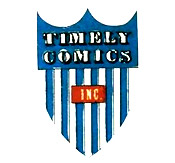
1939-1951

1951-1957

Until 1989
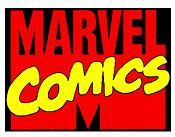
1989-2002

2002-
|
Marvel Entertainment was
originally known as "Timely Comics," and then "Atlas
Comics" (in the 1950s). At first, it produced 'pulp
magazines' or cheap fiction magazines and books.
Its Golden
Age superheroes included the following:
- the android Human Torch, the Angel and
Namor - the Sub Mariner, who first appeared in Marvel
Comics # 1 (October 1939), Timely's
ironically-titled first comic book
- Captain
America first appeared in Captain America Comics
# 1 (March 1941)
After decreasing sales in the late
1940s, however, the company abandoned its superheroes for
other horror and adventure comics, published by Atlas.
Then
in 1961 in the Golden Age of Comics, inspired by rival DC
Comics'
boosting of the superhero genre, the company started producing
comic books under the name Marvel
Comics, and again returned to the superhero genre.
American comic-book author, creator and chief
editor Stan Lee of Marvel Comics was a major influence
on the comic-book industry beginning in the late 1950s and
early 1960s. Known as "the father of modern comics," he
led the creation of superhero teams and additional characters
(some of which included the Fantastic Four, the Hulk, Thor,
Iron Man, the X-Men, Daredevil, Doctor Strange, Spider-Man,
the Avengers and many more). He was also responsible for reviving
characters from the 1940s, including the Sub-Mariner and Captain
America.
Stan Lee, Jack Kirby and others
at Marvel created an amazing sampling
of iconic superheroes in only two and a half years, comprising
the entire core cast of the "Marvel Universe."
- the Fantastic Four in The
Fantastic Four # 1 (November 1961)
- Ant-Man in Tales to Astonish # 27 (January
1962)
- The Hulk in The Incredible Hulk # 1 (May
1962)
- Spider-Man in Amazing Fantasy # 15 (August
1962); and then in Amazing Spider-Man # 1 (March 1963)
- Thor in Journey into Mystery # 83 (August
1962)
- Iron Man in Tales of Suspense # 39 (March
1963)
- Colonel Nick Fury in Sgt. Fury and
his Howling Commandos # 1 (May 1963), modernized
in Fantastic Four # 21 (December 1963), and
the leader of S.H.I.E.L.D. in Strange Tales # 135 (August 1965)
- Doctor Strange in Strange
Tales # 110 (July
1963)
- the X-Men in The X-Men # 1 (September
1963)
- the Avengers in Avengers # 1 (September
1963)
- Daredevil in Daredevil # 1 (April
1964)
Two of the original
Golden Age heroes returned to action:
- the Sub-Mariner
resurfaced in Fantastic Four # 4 (May 1962)
- Captain America, Timely Comics' WWII hero, came
back in Avengers
# 4 (March 1964)
By 1968, Marvel was selling 55
million comic-book issues a year, matching and surpassing
its rival DC. Marvel's readership has
always been younger than DC
Comics. To date, there have been
17 feature-length films based on characters and stories
attributed to Stan Lee - a record
for the most movies from the work of a comic book creator.
Marvel is currently owned by the Walt Disney
Company. |
There were a few other prominent comic-book publishers:
- Fawcett Comics, one of the earliest
publishers, originated Captain Marvel, one of the
best-selling superhero comics of the 1940s, who first appeared
in Whiz Comics # 2 (February 1940). Other popular
superheroes were Bulletman (and Bulletgirl).
- Dark Horse Comics, founded in
1986, has become known for alternative comics, such as Frank
Miller's Sin City.
- Image Comics, founded in 1992
(located in Berkeley, CA), responsible for DC/Marvel styled
superheroes, has become known for hit original series, such
as Todd McFarlane's Spawn, Rob Liefeld's Youngblood,
Witchblade, Kick-Ass, Robert Kirkman's The Walking
Dead, Invincible, The Darkness, Brian K. Vaughan's Saga, and Savage
Dragon.
- IDW Publishers, formed in 1999,
the youngest company, now publishes a majority of comics
licensed from movie and television franchises, including Star
Trek, Doctor Who, Transformers, G.I. Joe, and The
A-Team.
|
